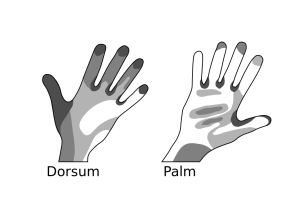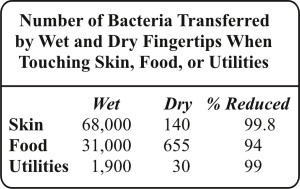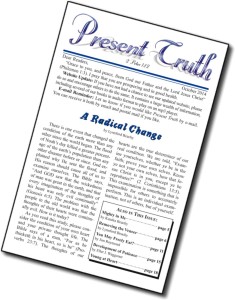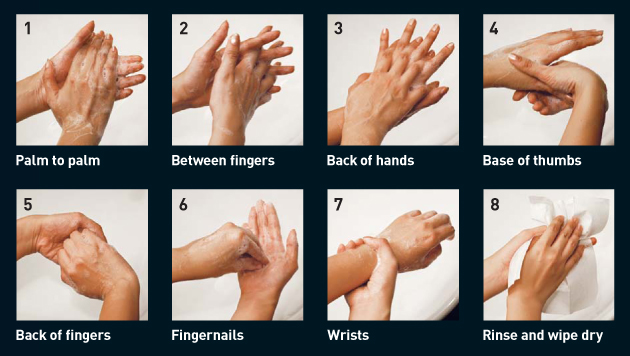Flu season is upon us, and our friends at the CDC are franticly threatening us with Ebola. The most scientifically sensible advice I’ve seen, to date, is that, due to the lack of a proven preventative for this potential scourge, the best defense is “extreme cleanliness.” This approach involves at least three key steps that are within our spheres of control: Minimize unnecessary exposure—avoid picking up the bug! Scrupulous hand washing—don’t get it in your mouth and don’t “hand it off” to others! Keeping a fastidiously clean and sanitary environment at home and the workplace, wherever you can control it, is critical to lowering the risks of perpetual recontamination. Follows is a timely updated course on the critical skill of how to properly wash your hands.
Hand Washing for all Seasons
In spite of its complexity, hand washing only takes seconds to do correctly. Few are the behaviors having such far-reaching health consequences. With all that is at stake, hand washing must be a mindful event. It is literally hand to hand combat against a simple but persistent global enemy using the most basic form of opportunistic germ warfare. It is a battle in which the health and wellbeing of many are at stake. Some of whom may be quite a distance from the local scene. Only patient diligence in practicing the battle plan over the long haul will win this germ war. Take heart, the effectiveness of the hand to hand battle behaviors can be easily improved by training and mindful understanding of the objective, the process, the tools, and the enemy.
This term, mindful, will come up a lot so let’s lay out a working definition of all that mindful implies herein. You are mindful when: creative imagination is alive, purposefully and thoughtfully aware of the goal, intentionally engaged in understanding and improving both process and outcome quality; acutely conscious of the modes of contamination and infection, and of the fact, that, in the case at hand, you literally hold the fate of others (near and far) in the palms of your hands—this is no place to intellectually cop-out nor cut corners.
The context of this discussion centers around bacteria that are called transient germs (in this writing, any reference made to microbes, germs or bacteria are essentially equivalent and can also include yeasts, molds, and viruses), most of which are easily picked up from soil, water, animals, hand-contact surfaces, other people, and the over growth of bacteria which often inhabit the unseen recesses of the microscopic folds of our own skin. Some of these transient germs may be or can become formidable enemies (called pathogens) and can cause pesky illness or even death. These pathogenic germ enemies can never be eliminated totally, nor can a truce be made, so they must be kept within certain boundaries and their numbers must be kept low enough for the immune system to handle. No paranoia allowed here, germs are not intentionally out to “get” people, nor has God left people defenseless. So, be mindful. Be diligent, not fearful. Because they are ready to go, the best way to help everyone everywhere is to wash them down the drain and mindful hand washing is the best way.
Our objective is a 90% reduction in transient bacteria, and is only attainable as the result of proper hand washing. Mindful hand washing knocks the transients off the skin by pitting one hand against the other. In this case both hands need to know what the other is doing, and this is accomplished by mindfully moving them in varying counter positions, to apply skin to skin friction covering every square millimeter of the hands from fingertips to wrists. This is the objective; a 90% reduction in transient bacteria is the result.
Mindful Action—Being mindful and purposeful during hand washing is imperative if we expect to arrive on the other side with clean hands. The Bible says, “Whatsoever thy hand findeth to do, do it with thy might;…” (Ecclesiastes 9:10). Physically, a mindful approach is essential to take the disconnected snap-shot hand washing steps “off the poster on the washroom walls” and make hand washing one graceful movement. A moral understanding of the life-saving potential of hand washing driving a sanctified imagination can facilitate a mindful connectedness to the bigger picture, by relating hand washing to our inherent social responsibilities that stretch personal hand washing to global health. Saving lives is, after all, the highest calling for hand washing.
Mindful study of the hands. To begin, fully open the primary hand to examine the topographical angles, textures, highs and lows that will work against making effective hand to hand contact. While opening and partially closing the primary hand, examine it from every angle. Notice how the 3-dimensional complexity changes various contours by smoothing or deepening creases, crevices and pockets that can trap and hide bacteria. Next, match hands palm to palm, and palm to dorsum (back of hand) to plan how to match high spots to low spots, flats to curves, and the many other opposing contours to ensure total skin contact on both hands. The next learning event adds a layer of information by showing areas on the hands which are frequently missed when washing hands. In the Missed Areas illustration, the darker the shading the more frequently the area is missed or under washed. This happens when the correct steps are not followed completely. The objective is to make sure that all areas are washed well and that includes all darkened areas in the diagram. Another cause of inequity of coverage to be aware of is that right handed people tend to wash the left hand more thoroughly than the right hand. Likewise left handed people give more attention to the right hand. So be mindfully even handed.
8-steps to Safe Hands
Important Lead-in Steps, 1. Make ready a clean towel within direct and unrestricted reach until needed at the end of the washing process.
2. Wet hands with water. If using a washing agent, add the water in the order that best works to sufficiently cover all hand surfaces with the chosen agent.
Important Final Steps, 1. Thoroughly rinse hands in running water while continuing to repeat the above steps for a few seconds or until all washing agent is rinsed away. (Note: Avoid the instinctive, uncontrolled shaking of the hands. It shamefully splatters contaminated water over an ovoid radius extending several feet in both directions! For this reason, it is always best to use washroom facilities whenever possible.)
2. Use the clean towel to thoroughly dry the hands starting from fingertips to wrists. This usually takes about 10 seconds.
3. If the towel is for a single service, use it to deal with any needed contact with utilities and exiting surfaces.
The steps shown in 8-steps to Safe Hands are adequate to get the job done, but the 8 photo frames can show only where the camera stopped the action in the entire range of motion. Likewise, it cannot reveal the movements on either side of the pose to support an understanding of the seamless transitions (if indeed there were any) from one step to the next. If the process of frequent daily hand washing is ever going to be something more than just “8 more things I gotta do” there must be some source of pleasantry or value akin to (even if not as intense) the graceful, fluid movement of ice skating, walking, fly casting which can be a joy to watch and experience. The next goal on this journey to make hand washing a sustainable component of daily life is to add something akin to the joy of movement, social connectedness, or some way of adding value to the whole earthly milieu into the hand washing experience. This very important job is left to the user. Connecting to the pleasure of movement itself can be started with visualizing and personalizing the order and movements until it all works best.
Ready to put it all together? Accessing all that was gained by the mindful study of the three preceding learning events, the processing centers of the brain should be ready to use the God given imagination faculties to “Draw out” the stagnant positions in the 8-steps to Safe Hands illustration to create a mental 3D movie scene for each frame. Each scene must supply the missing hand contact motion that will cover all parts of the hand surface including as many of the commonly missed spots as the position will comfortably allow. After thinking up a working scene for each of the 8 frames (or at least 2) start trimming the starting and ending parts of each scene to connect the motion between the scenes that fits the best until the whole process flows together like one smooth “dancing hands” routine.
Personal examples include: The position suggested in frame #4 is awkward. Reversing the grip so the hands are aligned flows better; it does not challenge the wrists, and the hands fit a little better under the water stream. The thumb tips and nails may also be addressed during this scene. Neither frames #5 or #6 work well at all for hands with nails that are not kept trimmed to the nail bed. If nails are not so trimmed, a nail brush with appropriate bristle length is a requisite accessory tool. Find a small brush or make one from the head of a quality tooth brush. Trim or remove the handle to fit pocket or purse). The longer the nail the more effort is required to reduce bacteria levels. Artificial nails are porous and may offer a safe harbor to tremendous numbers of germs and fungus which are much easier to share than to remove. For nails not trimmed past the fingertips, position the fingers at a lower angle than shown in frame #6 so all the nails just barely touch the palmer surface while working the fingertips back and forth and circularly in the hollow of the palm. Back to frame #5 which not only can be painful with nails, but it does not fit neatly under the water stream. Modifying this pose so the hands are aligned (as in frame #4) and alternately resting the nails of one hand on the heel of the partnering palm seems a better fit while including more dorsal finger contact (almost to the 3rd knuckle). Both hands and the curved fingers need to be moving (scratching-like and rotational) so the palmar skin and nails make good contact and the palmar skin can work into the connecting crevices at each side of the nails. While in this pose, sliding the sides of the fingers against each other, as if drumming impatiently on a table, adds contact friction time to the sides of the fingers without adding any more time to complete the whole step. Make sure the personalized hand washing time and effort fit the chosen nail style using lowered angle or brush.
 As the owner, feel free to personalize the routine by changing the order of the 8 frames or scenes and /or even the position suggested in the frame. Own the routine and make it work the best; make it one of life’s little joys. It offers a far-reaching value that will “Pay It Forward” to the health of many people.
As the owner, feel free to personalize the routine by changing the order of the 8 frames or scenes and /or even the position suggested in the frame. Own the routine and make it work the best; make it one of life’s little joys. It offers a far-reaching value that will “Pay It Forward” to the health of many people.
Drying hands after washing is a critical step in microbe reduction. Washed, but still wet, hands will transfer an average of 68,000 bacteria from the fingertips when touching skin, whereas dry hands will only transfer 140 (a 99.8% transfer reduction rate).
It takes about 10 seconds to dry the hands to a 96% moisture level with natural fiber toweling. Using a blower type hand dryer, it takes 45 seconds to achieve the same dryness. The bad news is that air-blower dryers are known to accumulate and concentrate fecal material and germs from the air in the toilet room.
Obviously skin to skin bacterial transfer is much greater when moisture is present. So if the next handshake feels a bit too damp, head to the washroom and avoid the blow dryer; if no towels are available, seek toilet paper or seat cover paper. To be Continued…
Blessings! JR


